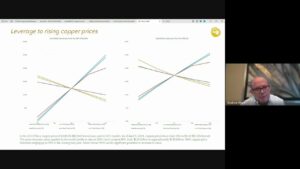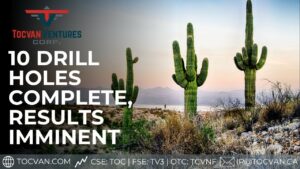Tarsis Resources Ltd. (TSXV: TCC) (“Tarsis” and “the Company”) is pleased to
announce that the Company has arranged a private placement of 3 million units
at $0.075 cents to raise $200,000. These funds will be used primarily to
advance Tarsiss Yago Gold project. Tarsiss geological team has
identified priority targets on the Yago project that can be advanced
geologically with additional work programs. The work programs are intended to
upgrade the Yago Gold Targets and attract more potential partners for further
exploration work.
The financing units are comprised
of one common share and one common share purchase warrant which entitles the
holder to buy another common share at $0.15 for a period of three years.
As a Prospect Generator, Tarsis
works to facilitate the majority of its exploration funding through option
partnerships. This work program will be focused on the La Tejona area of the
Yago Property and may include further surface sampling, soil sampling, mapping,
trenching, additional prospecting, and other test work. A better set of
technical geological data will help to attract senior partners to the project.
Community relations work has also
been started in the area to maintain good relationships with the local
stakeholders.
La Tejona
The La Tejona prospect is defined
by a fairly well constrained gold-in-soil geochemical anomaly with the majority
of the gold threshold values exceeding 100 ppb to a maximum of 980 ppb.
The main anomaly trends north-easterly for approximately 1,700 m and is
open along strike to the southwest. Anomalous response tapers to the
northeast into a valley bottom and beneath cover rocks.
Prospecting along the surface
trace of the main La Tejona gold anomaly by previous operators identified
intermittent accumulations of clay alteration, silicification and quartz
veining as subcrop and outcrop in excess of 10 m widths at a number of
locations. The largest concentrations of this material are contained
within the southern portion of the anomaly but surprisingly, very little to no
sampling of this material is documented. A possible reason for the lack
of sampling is that most material appears to be chalcedonic/opalescent in
character and more indicative of silica deposition above the gold-rich zones in
these systems.
At the northeast end of the main
anomalous trend, a 55 m outcrop exposure of silicification and quartz vein
material obliquely bisects the gold-in-soil anomaly along a narrow drainage.
The alteration zone strikes north-northeast to northeast and is interpreted
to dip moderately to steeply toward the southeast between 53 and 72 degrees.
Previous chip sampling across a number of natural exposures along the
creek returned mixed results for gold ranging from 2 ppb to 4.18 g/t over 0.90
m sampled. Silver grades were in turn highly variable ranging from below
detection to 212.8 g/t across 0.90 m.
Tarsis collected two series of
sawn channel samples across partial outcrop exposures of silicification plus
banded and brecciated epithermal quartz vein material. Significant assay
results are shown in Table I.
Table I La Tejona Sawn Channel Sample Results
Trench
| Width
| Gold
| Silver
|
LT-13-01
| 2.88
| 3.10
| 35.6
|
including
| 0.85
| 8.49
| 29.9
|
including
| 0.57
| 13.65
| 57.4
|
|
|
|
|
LT-13-02
| 4.83
| 2.22
| 50.2
|
including
| 2.14
| 4.34
| 95.2
|
* true vein thickness is believed
to represent approximately 85% of the sawn sample widths.
The two sample sites were located
12 m apart and started at or near the hanging wall contact of the alteration
zone. LT-13-01 contained 10 samples totalling 5.29 m while LT-13-02
contained 9 samples for a total of 6.17 m. Each channel ended in vein
material and both series of samples returned elevated gold values in excess of
0.70 g/t from the last sample collected toward the footwall, indicating that
additional sampling is required.
Textures observed on freshly cut
vein surfaces consist of: multiple phases of colloform banded
quartz-adularia accompanied by irregular bands of rimming fine black sulphide;
and hydrothermal breccias both containing quartz clasts and/or cut by at least
one later generation of quartz veining. Some cut surfaces also exhibit relatively
coarse accumulations of pyrite, galena and chalcopyrite.
The main structural alteration
zone at this particular location could exceed 15 m true thickness and the
samples collected by Tarsis only tested a limited portion of the mineralization
near the hanging wall contact.
Cursory prospecting was carried
out roughly 1,200 m southwest along trend of the main gold-in- soil anomaly
within an area previously mapped to contain a significant concentration of
quartz vein float; however no previous sampling of the material is documented.
An examination of two localized areas by Tarsis identified a combination
of chalcedonic/opalescent quartz and silicified/hydrothermally altered wallrock
containing moderate limonite and hematization across widths up to and exceeding
15 m across the slope. Two 6 m composite samples were collected across
the float train at one of the locations and one of these composites returned
0.42 g/t gold.
Stock Option Grant
The Board of Directors of Tarsis
have also approved the grant of 2,130,000 stock options exercisable at a price
of $0.10 per common share for a period of five years to Directors, Officers and
Consultants of Tarsis.
About Tarsis Resources
Tarsis is an exploration company
following the prospect generator business model. The Company acquires
prospective exploration projects by acquisition or through its own grass roots
generative exploration, adds value and then vends or options out projects to
partners for advancement.
On behalf of the Board,
Marc G. Blythe, P.Eng., MBA.
President and Chief Executive Officer
FOR FURTHER INFORMATION PLEASE
CONTACT:
Tarsis Resources Ltd.
Marc G. Blythe, P.Eng., MBA.
| Mark T. Brown, C.A.
|
This news release was
prepared by Company management, which takes full responsibility for content.
Neither the TSX Venture Exchange nor its Regulation Services Provider (as that
term is defined in the policies of the TSX Venture Exchange) accepts
responsibility for the adequacy or accuracy of this release.
























